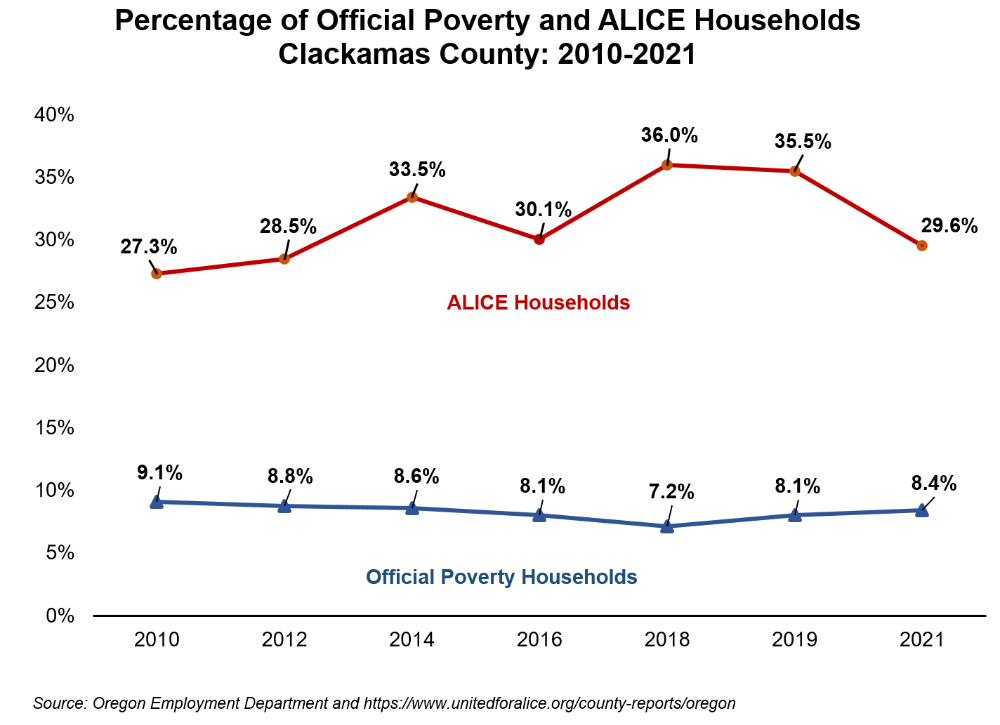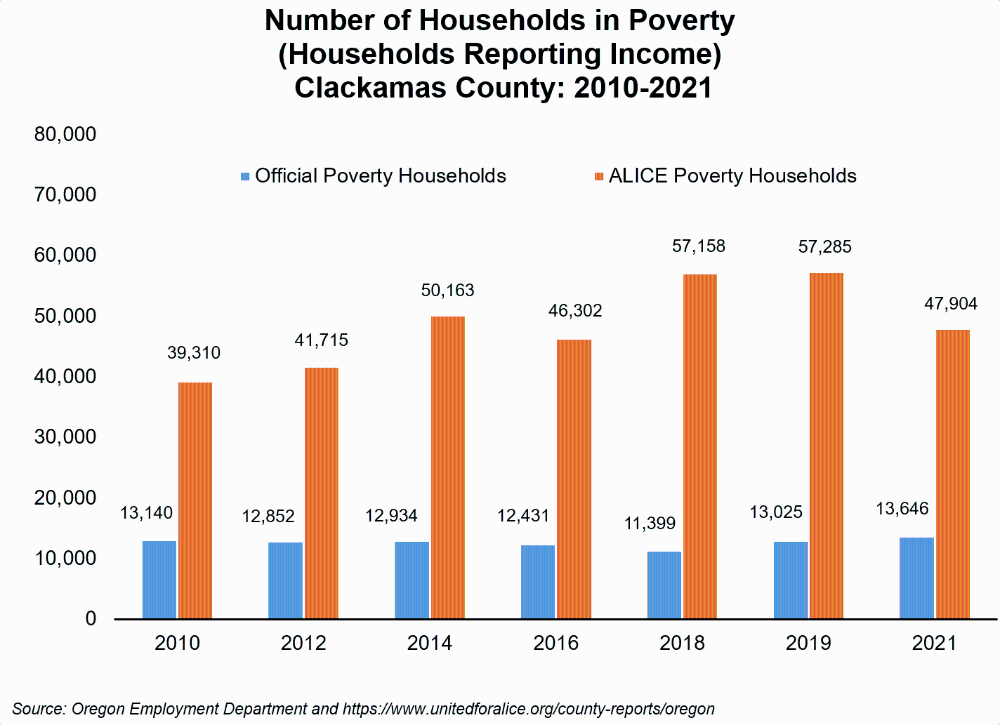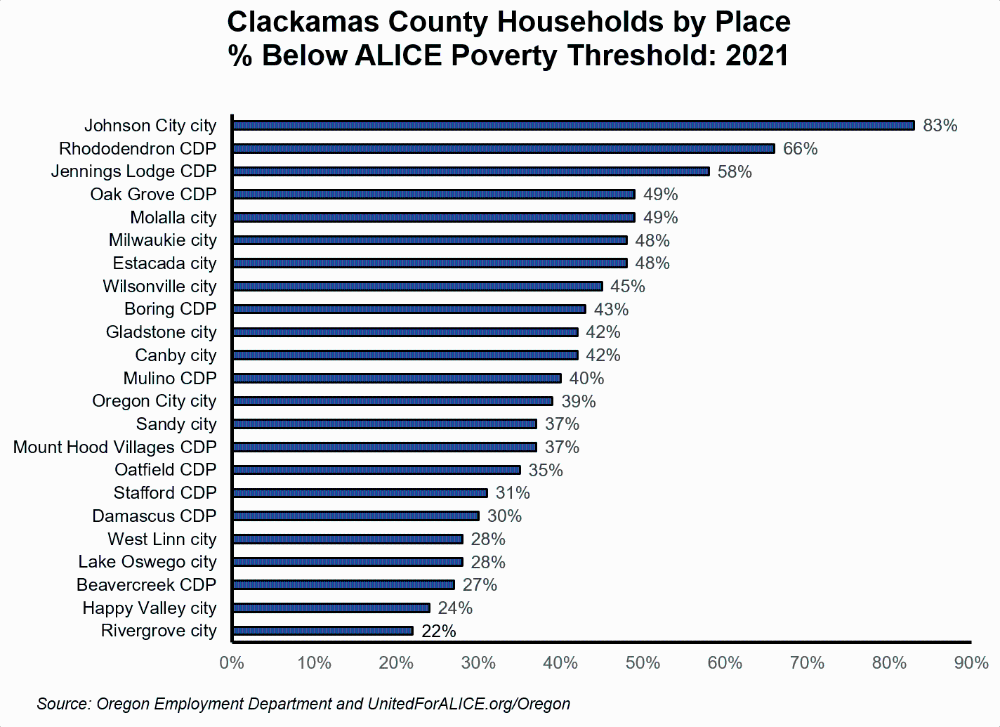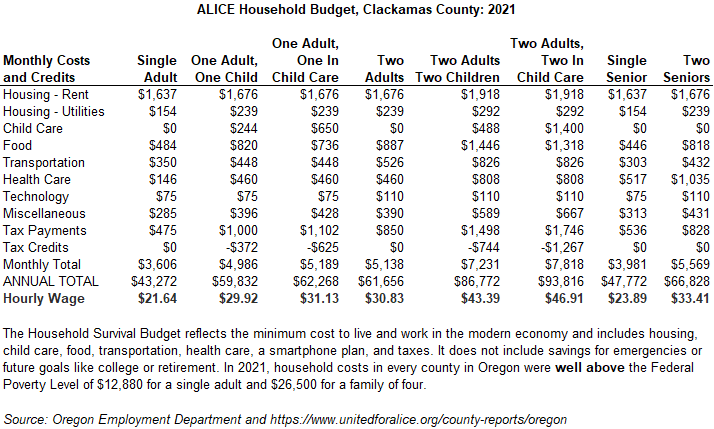Measuring Levels of Poverty in Clackamas County
September 25, 2023Although there are a number of measures used to estimate poverty levels, the two most common poverty measures used in the United States are the (1) U.S. Census Bureau’s Official Poverty Measure (OPM) and the (2) Supplemental Poverty Measure (SPM). The official poverty measure is based on cash resources. The second measure, the Supplemental Poverty Measure, includes both cash and noncash benefits and subtracts necessary expenses (such as taxes and medical expenses). This article will also take an in-depth look at a third poverty measure that was first created in response to COVID-19 and its financial hardship called the (3) ALICE Poverty Measure.
The Official Federal Poverty Measure
The Census Bureau determines poverty status by using an official poverty measure (OPM) that compares pre-tax cash income against a threshold that is set at three times the cost of a minimum food diet in 1963 and adjusted for family size. The OPM uses calculations of these three elements – income, threshold, and family – to estimate what percentage of the population is poor. These calculations do not take into account the value of in-kind benefits such as nutrition assistance, housing and energy programs or tax credits like the earned income tax credit or stimulus payments. They also do not consider regional differences in living costs or expenses such as housing.
The Supplemental Poverty Measure
The Supplemental Poverty Measure (SPM) does take into account family resources and expenses not included in the official poverty measure as well as geographic variation. First, it adds the value of in-kind benefits available to buy basic goods to cash income. In-kind benefits include nutritional assistance, subsidized housing and home energy assistance. Then, the model subtracts necessary expenses for critical goods and services not included in the thresholds from resources. Necessary expenses subtracted include income taxes, Social Security payroll taxes, child care and other work-related expenses, child support payments to another household and contributions toward the cost of medical care and health insurance premiums.
The ALICE Poverty Measure
The ALICE poverty estimate is an acronym for Asset Limited, Income Constrained, Employed and attempts to measure the number of households that earn above the Federal Poverty Level but still cannot afford the basic cost of living in their county or state.
Definition of ALICE households:
- Spans all races, ages, ethnicities, and abilities, though households of color are disproportionately ALICE.
- Includes workers whose wages cannot keep up with the rising cost of goods and services.
- Often includes those who are working two or more jobs and still cannot pay their bills.
- Includes family members who need care and assistance, which makes it harder for their caregivers to find adequate work.
- These households live paycheck to paycheck and are forced to make impossible choices: pay the rent or buy food, receive medical care or pay for child care, pay utility bills or put gas in the car.
ALICE households often do not qualify for public assistance. ALICE is calculated for all U.S. states and counties and attempts to estimate the minimum average income needed to afford housing, child care, food, transportation, health care, smartphone plan, and taxes.
The graph below shows the official poverty levels (OPM) in Clackamas County compared with the ALICE poverty level threshold measured in percentages for years 2010 to 2021 in Clackamas County. Below the ALICE Threshold includes both households in Poverty, with income below the OPM, and those that are ALICE, with income above the OPM but below the cost of basics. The poverty level threshold for ALICE households ranged from 27% to 36% during these years. This was 18.2 to 28.8 percentage points higher than the OPM levels during this same time period. It should be noted that the drop in the percentage of ALICE households in 2021 can be, in all probability, attributed to the unprecedented public assistance through pandemic relief measures during 2021.

In years 2010 through 2021, the number of households classified as “ALICE poverty households” were estimated to be three to five times greater than the number of households federally designated “official poverty households” from 2010 to 2021. Again, the drop in the number of households classified as ALICE in 2021 can probably be attributed to the pandemic relief assistance during that year.

There is a wide range of ALICE poverty thresholds among both incorporated and unincorporated places in Clackamas County in 2021. The largest shares below the ALICE poverty thresholds were seen in Johnson City at 83% (population 537), Rhododendron CDP at 66% (population 173), and Jennings Lodge CDP at 58% (population 7,953). The lowest poverty thresholds were seen in Rivergrove at 22% (population 552), Happy Valley at 24% (population 25,738), and Beavercreek CDP at 27% (population 4,026).

The ALICE House Survival Budget estimates the bare-minimum cost to live and work in an economy in each state and county in the U.S. The ALICE Budget is made up of conservative estimates for the cost of household essentials including housing, child care, food, transportation, health care, technology, miscellaneous expenses, and taxes. The ALICE household budget for 2021 in Clackamas County estimated that the minimum (living) hourly wage for a single person household with no children was $21.64 an hour or $43,272 a year. Additionally, the minimum living wage for one adult household with one child in childcare rose to $31.13 an hour or $62,268 a year.

Why Poverty Measures Matter
Research strongly suggests that every individual and family requires adequate income to be healthy and able to contribute to their communities and succeed in school, the labor market, and beyond. The National Center on Children in Poverty (NCCP) created the Family Resource Simulator to illustrate the impact of work supports, including income tax credits and child care assistance. The simulator suggests families typically need nearly twice as much as the official poverty measure to afford rent and utilities, child care, health insurance premiums, out-of-pocket medical expenses, transportation, debt and payroll taxes. The Economic Policy Institute’s Family Budget Calculator, and the Massachusetts Institute of Technology’s Living Wage Calculator, each budget-based measures of real-world costs, come to similar conclusions. The OPM budget is significantly lower than these alternative budget-based standards of living.
According to UnitedForALICE.org, the number of households in financial hardship in Oregon continues to be undercounted by official measures. According to the official poverty measure, 12% of Oregon households were in poverty in 2021 while ALICE data shows that another 32% were ALICE poverty households.
ALICE households that experience financial hardships are as diverse as the communities they live in. Nearly 30% of households in Clackamas County earned below the ALICE Threshold in 2021, which meant that nearly 48,000 households were forced to make difficult choices and risky trade-offs each day.
Ultimately, if ALICE households can become financially stable, state economies across the country will be stronger and communities more vibrant, improving life not just for ALICE, but for everyone. ALICE household data is available at both state and county levels and contains data on race/ethnicity, household composition (families with children, single households), and age of householder. The most current data are available here: